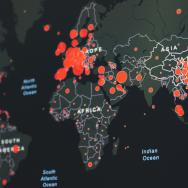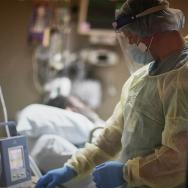The worldwide economic landscape has changed dramatically over the past four months, as the COVID-19 pandemic has stalled activity in nearly every corner of the world.
With these dramatic changes in mind, the University of Chicago Booth School of Business has convened its inaugural virtual Economic Outlook, focusing on the U.S., Asia and Europe in three events over three weeks.
During the April 30 debut of the online series, Profs. Randall S. Kroszner, Austan D. Goolsbee and Raghuram G. Rajan discussed the critical economic questions facing the world amid the COVID-19 crisis.
Moderated by Kathleen Hays of Bloomberg, the conversation ranged from the possible paths and pitfalls for recovery, to how economic sectors such as manufacturing and hospitality will fare, to concerns about incurring debt.
While much uncertainty remains, the Chicago Booth economists shared their perspectives and concerns around key questions facing business leaders, policymakers, employees, and families worldwide. Portions of the first event are highlighted below.
How have stay-at-home orders affected economies?
With tens of millions of unemployment claims in the United States, as well as more than 100 million jobs lost in India, global economies are suffering.
“We sent everyone home. We didn't allow people to go out and buy anything,” said Kroszner, a former governor of the Federal Reserve System who serves as Booth’s deputy dean for executive programs and Norman R. Bobins Professor of Economics. “So it's not a surprise that you get this astonishing contraction in demand and production.”
Hoping for a ‘reverse check mark’
A former chair of the Council of Economic Advisers and a member of President Barack Obama's cabinet, Goolsbee warned that a traditional recession recovery is a slow process.
“We could go from less than 4% unemployment to 15% in a short period of time. In a normal recovery, the unemployment rate only goes down 1 to 1.5 percentage points a year,” said Goolsbee, the Robert P. Gwinn Professor of Economics.
“Hopefully there is the possibility of a rapid recovery—maybe a reverse check mark where you went down, and then you came back at least part of the way at kind of a rapid pace. We absolutely have to do everything we can to go in that direction because the alternative is much more grim.”
Should the government bail out everyone?
Some sectors, such as manufacturing, can likely come back quickly, said Rajan, who previously served as the governor of the Reserve Bank of India and the chief economist and director of research at the International Monetary Fund. Others, however, will take much longer to fully recover—if they ever do at all. Those differences need to be taken into account when considering government interventions.
“One of the decisions we have to make soon is how the government spends that money,” said Rajan, the Katherine Dusak Miller Distinguished Service Professor of Finance. “It’s going to be expensive to keep the hospitality industry alive for a year or more until people feel comfortable going out again.”
Which sectors might expand or contract?
Kroszner said that an effective recovery strategy should consider which types of jobs will be available in the coming years and how to ensure that employees have the skills to fill them.
“Well-intentioned programs that are trying to freeze things as they were in February are going to make it more difficult for people to find new positions,” Kroszner said. “At some point we're going to have to allow for a transition. We've got to get the support structures right to get people moving into new sectors.”
Restarting regular economic activity
Goolsbee said that the shortest path to recovery is by spending on health care and testing.
“The most important thing you can do for the economy is slow the spread of the virus,” he said. “That’s how you stimulate the economy, because people have to feel safe leaving their homes. We’ve now got six countries that have gotten out of lockdown and are going back to normal. Each of them has done extensive testing to get the rate of the spread of the virus low enough that it peters itself out.”
Paying off debt
Goolsbee said there’s no alternative to adding to the debt, but we should be considering the long-term implications for paying off these debts.
“Nobody in June of 1944 questioned how to pay for D-Day and keep it revenue neutral,” he said. “If you look post-World War II, we went through a period of heavy taxation to pay back the debts that we accumulated. It's what we should have done, and spreading that over time is better than trying to pay for it all at once. The same is true here.”
Rajan added that these burdens could also affect future investment.
“This was the debt overhang problem that many emerging markets had,” Rajan said. “We should be wary when we have lots of debt and potential taxation down the line. A lot of investors are going to be worrying about where it's going to fall, and that could be perhaps very damaging for investment and growth.”
—This story was first published by Chicago Booth. Register here to attend the next event in the virtual Economic Outlook series on May 13, featuring Profs. Veronica Guerrieri, Randall S. Kroszner and Brent Neiman.

